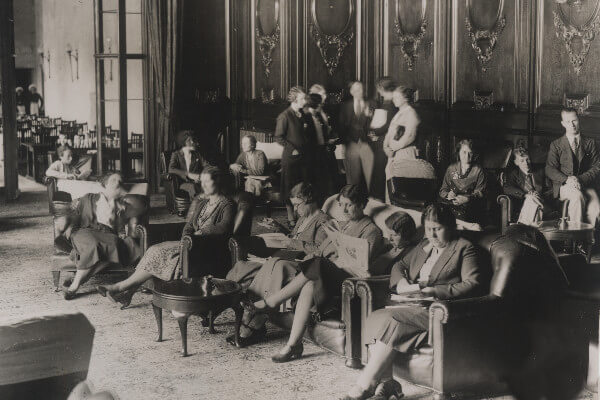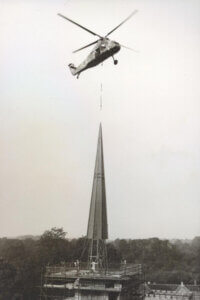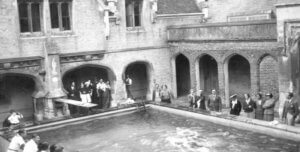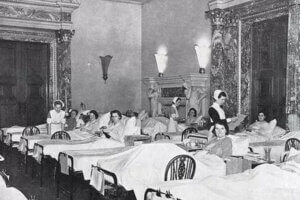From Pilgrims to Party-goers

If the walls at Ashridge could talk, they’d have many tales to tell – having witnessed visitors and residents including Elizabeth I, Winston Churchill and even Oscar Wilde.
Today, Ashridge House is home to a restaurant, the Bakehouse cafe, and is well known for its Christmas lights display.
But 800 years ago, it was a favourite destination for a different kind of visitor. Ashridge’s history began with a holy relic – a phial of the blood of Christ is said to have been collected at the crucifixion by Joseph of Aramathea (legend has it that Joseph (Mary’s uncle) brought Jesus to England when he was a boy and they visited locations including St Just in Roseland and St Michael’s Mount). The phial was a prized possession of Emperor Charlemagne, but it was somehow ‘acquired’ and brought back to England.

Meanwhile, in the 1200s, King John (he of Robin Hood fame) had two sons. Henry became Henry III after his father’s death, and younger son Richard was gifted Berkhamsted Castle. Richard had a son, Edmund, Earl of Cornwall, and it was Edmund who, in 1283 founded a monastery at Ashridge in order to create a place of pilgrimage for a phial of the Sacred Blood of Jesus Christ that he had acquired while travelling in Germany.
Nigel Bradshaw has worked at Ashridge House for many years, and is an expert on its history. He says: ‘This was at a time when myths surrounding the Holy Grail were at their height – and in terms of fame and popularity, the phial was more important than the Shroud of Turin – it was a really big deal!’
The Monastery also featured a hand-dug 90m deep well, which is still on the site 800 years later.
It was also Edmund who created the deer park at Ashridge – it became a popular spot for hunting for his relations – who were the royal family. The current deer on the estate are descendants of those original animals.
Ashridge has a long history as a centre of education – in fact it dates back to the 1300s. Nigel explains: ‘In the 14th century Edward Prince of Wales (the Black Prince) gave a substantial amount of money to the monks to set up the college of the Bonhommes, which had an excellent reputation for the quality of its education. It was already a very wealthy monastery because of all the pilgrims – being only 40 miles from London made it a popular spot.’
However, in 1537 the Priory was abolished during the dissolution of the monasteries (and possibly that’s when the holy relic disappeared), in order to allow Henry VIII to become head of the Church of England, divorce Catherine of Aragon and marry Anne Boleyn. Henry decided to keep the land as his own, thanks to the presence of the Ashridge deer. Although he did not spend much time there, his three legitimate children, Mary, Elizabeth, and Edward lived at Ashridge on and off over the next few years. (Nigel explains that, for sanitary reasons, the wealthy avoided living in one place for long).
It was to Ashridge that Elizabeth fled from her sister Queen Mary (Bloody Mary) who saw her as a threat to the throne – and it was also at Ashridge that Elizabeth was arrested and taken to the Tower of London on suspicion of treason. She never returned to the estate.
After her death the house was bought by Lord Chancellor Thomas Egerton – he called it the little house in the woods. Nigel adds: ‘He was married to Alice Spencer – but unfortunately they couldn’t stand each other so he would often slope off to Ashridge!’
The house stayed in the family for generations and one of the descendants was Francis Egerton. He was kept away from the running of the estate and instead sent to learn with a tutor (as his mother thought him sickly and not very bright). One of the lessons he learned was the power of the canal systems in Italy.
The family had inherited an estate in Cheshire and Francis, now the Third Duke of Bridgewater, and James Brindley created the first man-made canal to transport coal from the family’s estates from Worsley to Central Manchester. It made him a very wealthy man – and when he died he left a £2m fortune. So much for not being very bright!
The money left allowed his cousin John Egerton, who became the 7th Earl of Bridgewater, to create the house we know today in the Gothic Revival style.
The 7th Earl of Bridgwater had no children, so in 1851 when his great nephew, Viscount Alford inherited, he and his wife The Lady Marian brought new heights of splendour to the house.
Nigel tells us more about Lady Marian: ‘She was the daughter of the Marquess of Northampton – she was quite high born and spent the first 17 years of her life in Rome. She would invite playwrights and scholars to Ashridge House – they would have very cultural parties – Oscar Wilde was a regular visitor. She was also a favourite of Queen Victoria. The third Earl of Brownlow – her son – was great friends with the Prince of Wales (later Edward VII), and his wife was a great confidante of the Princess of Wales – I bet there were some amazing stories she would have heard!‘
The Earl of Brownlow would organise big hunting parties, thanks to the Ashridge deer on the estate and the guest list included heads of state and crown princes of Europe.
Lady Marion was also a great friend of Princess Louise – and together they set up the Royal Needlework College in London.
When Lady Marian’s son Lord Brownlow and his wife died, having had no children, the estate was sold – by this time there were 18 villages within the estate! There were plans to knock Ashridge down and build a housing estate, but instead it was bought by MP Urban Hanlon Broughton as a gift to the Conservative party to commemorate the life of Prime Minister Andrew Bonar-Law. The Memorial Trust came into being and Ashridge House opened as a College. This was a project that John Buchan, the author of The 39 Steps, was involved in.
 In 1939 the house was taken over by the Ministry of Defence and became a very important military headquarters. France’s Charles de Gaulle was billeted in a safe house in Little Gaddesden in 1939 – and Winston Churchill was a constant visitor to Ashridge – negotiating with De Gaulle to bring him back into power.
In 1939 the house was taken over by the Ministry of Defence and became a very important military headquarters. France’s Charles de Gaulle was billeted in a safe house in Little Gaddesden in 1939 – and Winston Churchill was a constant visitor to Ashridge – negotiating with De Gaulle to bring him back into power.
 During both wars, Ashridge House was also a wartime hospital with more than 20,000 patients coming through its doors, including 400 soldiers from Dunkirk.
During both wars, Ashridge House was also a wartime hospital with more than 20,000 patients coming through its doors, including 400 soldiers from Dunkirk.
Between 4,000 and 5,000 babies were also born in the makeshift maternity ward.
In another connection to the military – a battalion of American soldiers were camped out in the woods in Ashridge. There’s still a tree engraved with the home counties of everybody that was stationed there, along with the date – April 1944 – and the word ‘victory’!
After the war, the house once again became a centre for education, as a finishing school for ladies called the House of Citizenship, then in 1959 it became home to Ashridge Executive Education, ranked as one of the best business schools in the world, then in 2015, Hult International Business School took over the business. Subsequently, in 2020 E F Corporate Education (another Hult Company) purchased Ashridge House and started a restoration programme.
Find out more about upcoming tours of the house at www.ashridgehouse.org.uk.
With thanks to Nigel Bradshaw for his assistance with this feature.
